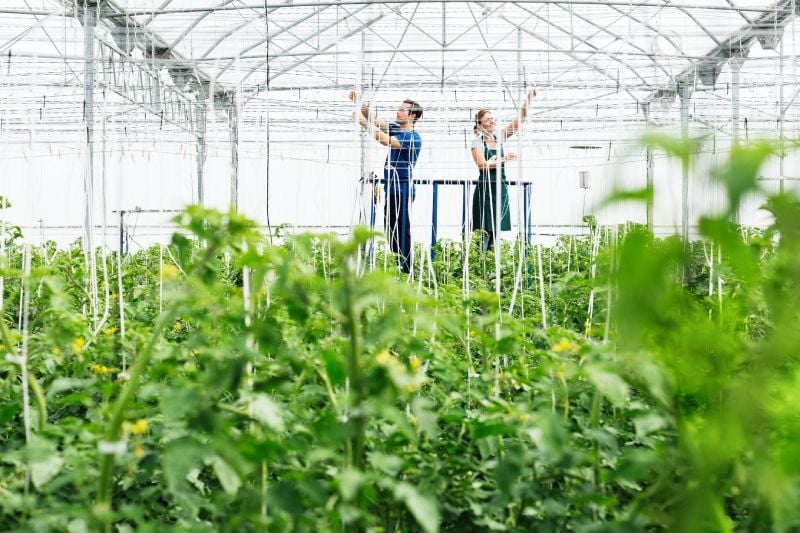Vertical Farming in Greenhouses: Maximizing Space and Productivity
)
The need for wholesome, fresh food is growing along with the world's population, and conventional farming practices are finding it difficult to meet this demand. Growing in popularity is a novel approach called vertical farming in commercial greenhouses. This method maximizes the utilization of available space by growing crops vertically, potentially transforming the production of food. Let's explore the advantages, methods, and potential applications of vertical farming in greenhouses.
Comprehending Vertical Farming
The practice of growing crops in integrated structures or vertically stacked layers in a controlled environment is known as vertical farming. By using this method, fresh food can be produced near to consumers in urban areas, saving money on transportation and having a smaller environmental impact.
Vertical Farming's Advantages in Greenhouses
Space Optimization: Horizontal space is a constraint on traditional farming techniques. By making use of vertical space, vertical farming raises the number of crops per square foot. This is especially helpful in cities where land is expensive and in short supply.
Better Crop Yields: Vertical farming has the potential to provide far better crop yields by making the most use of available space and creating the best growth environment. Consistent light, nutrient, and water availability helps plants grow more quickly and healthily.
Resource Efficiency: Systems for vertical farming are made to use resources more wisely. Water conservation is ensured by sophisticated watering methods like aeroponics and hydroponics. Furthermore, waste is decreased because nutrients are given straight to the roots of the plants.
Diminished Environmental Impact: Since the controlled environment restricts pest access, vertical farming in greenhouses reduces the demand for pesticides and herbicides. As a result, there are less chemicals in the environment and food. Furthermore, food production nearer urban areas results in a large reduction of transportation-related carbon emissions.
Production All Year Long: Regardless of the outside weather, greenhouses outfitted with vertical farming systems are able to produce crops all year long. As a result, fresh produce is consistently available, enhancing food security.
Methods Used in Vertical Agriculture
Hydroponics: Plants are nourished by nutrient-rich water in this soilless growth technique. The roots of the plants are immersed in the nutrient solution while they are cultivated in a media like rock wool or coconut coir. With hydroponics, you can precisely control the nutrients and use water very efficiently.
Aeroponics: This method involves suspending plants in the air and misting their roots with a nutrient-rich solution on a regular basis. Compared to hydroponics, this technique utilizes even less water while promoting quick growth. Additionally, it improves the health of the plant by allowing the roots to receive more oxygen.
Aquaponics: A symbiotic environment is created by combining hydroponic gardening with aquaculture, or the raising of fish. The plants help filter and clean the water, which is then returned to the fish tanks, while the fish waste supplies the nutrients for the plants. This closed-loop system uses resources very effectively and sustainably.
LED Lighting: In order to guarantee that plants in vertical farming receive enough light for photosynthesis, artificial lighting is essential. Because LED lights are energy-efficient and can provide plants the precise light spectrum they require for healthy growth, they are the favoured option.
Automation and Monitoring: Technologies for automation and monitoring are integrated into sophisticated vertical farming systems. Sensors and IoT devices track characteristics such as temperature, humidity, light, and nutrient levels. Real-time conditions adjustments are made by automated systems, which guarantee ideal growth conditions and lower labour expenses.
Difficulties and Opportunities for the Future
While vertical farming in greenhouses offers various benefits, it also brings challenges:
High Initial Costs: Setting up a vertical farming system involves a considerable initial investment in infrastructure, technology, and equipment. Over time, though, these expenses may be outweighed by the long-term advantages and high yield potential.
Technical expertise: Plant science, engineering, and technological knowledge and expertise are necessary to operate a vertical farming system. To properly manage and fix these complex systems, farmers need to receive training.
Energy Consumption: LED lighting is energy-efficient, but even so, vertical farming systems need a lot of energy for automation, lighting, and climate control. Purchasing renewable energy sources can assist in reducing this problem.
The future of vertical farming in greenhouses appears bright, even with these obstacles. Innovations in technology, like as AI and machine learning, are boosting the efficiency and productivity of vertical farms. Furthermore, research and investment in this field are being driven by the growing interest in locally produced and sustainable food.
Vertical farming in greenhouses represents a paradigm shift in agricultural operations, offering a sustainable alternative to meet the food demands of an ever-growing population. By maximizing space, improving crop yields, and promoting resource efficiency, vertical farming has the potential to transform the way we produce food. As technology progresses and expertise in this field expands, vertical farming will undoubtedly become a cornerstone of modern agriculture, assuring a continuous and sustainable supply of fresh vegetables for future generations.
Contact Cultivate and Equipment to learn more about your greenhouse needs.
| Tags:GreenhouseLatest News |

